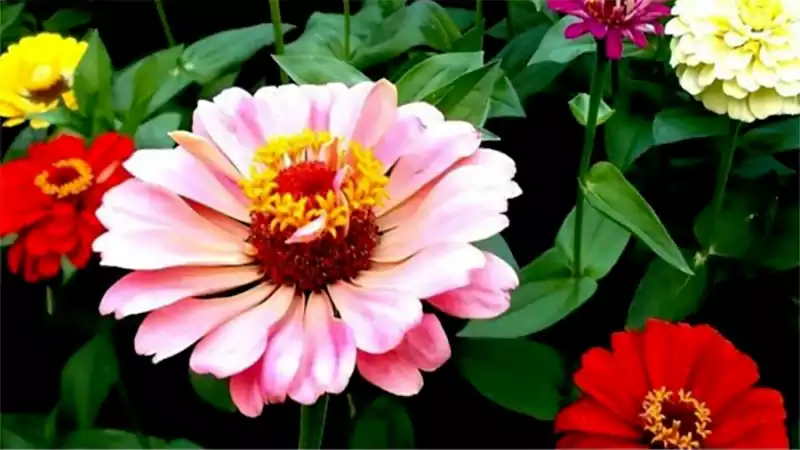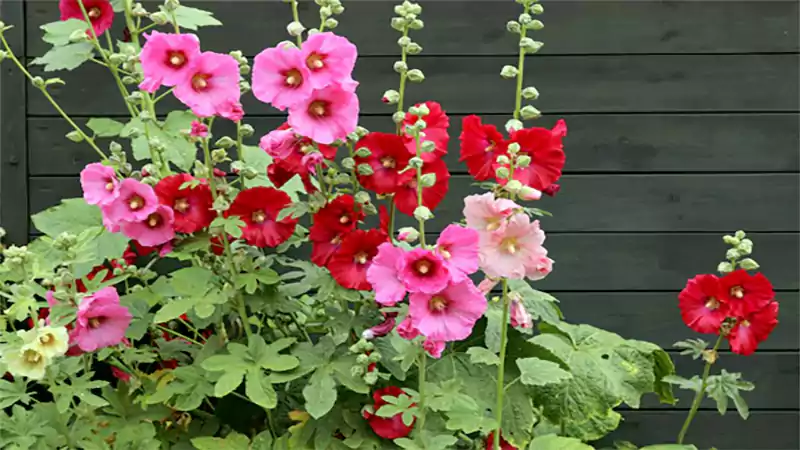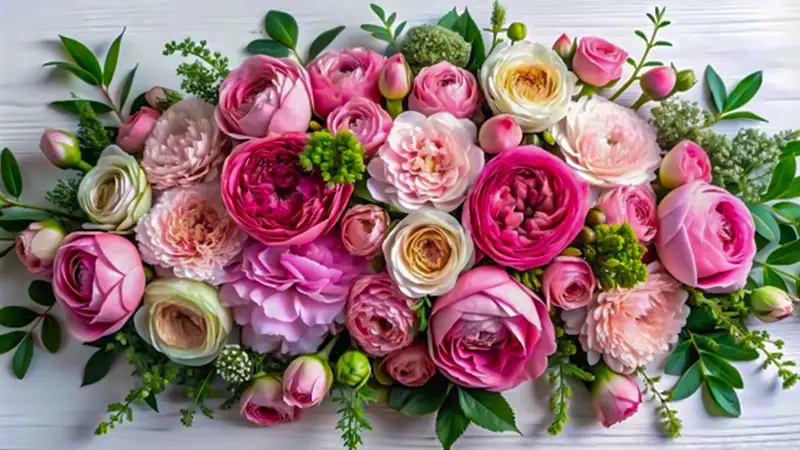
The flower known as Ranunculus, also referred to as Persian Buttercup, is one of the most beautiful flowers that can be grown.
With perfect rose-shaped buds, this flower comes in a range of colors, from creamy white to rich pink flower, making it an elegant addition to any garden, any event, or any flower arrangement.
The spectrum of Ranunculus colors makes it one of the most sought-after plants to add sophistication in any space whatsoever. Its intricate and frilled petals that come in layers are every bride’s favorite. Many brides handpick Ranunculus and include these in their wedding bouquets.
The following guide covers every little detail about Italian Ranunculus flowers, including:
- What is Ranunculus?
- How to Grow Ranunculus?
- What are the key steps to selecting and planting Ranunculus corms?
- Why is it important to protect Ranunculus from pests and diseases?
Understanding Ranunculus Flower: An Overview
Ranunculus is a genus of flowering plants that is commonly known as the new buttercup family. It is also much regarded for its ornamental nature. The most available and cultivated unit regarding gardens and floral arrangements is Ranunculus asiaticus, a species known for its stunning and elaborate vanity of flowers.
The flowers bear a wild semblance to kitties and muted banging boats; however, they can be boisterously cared for, which is surprisingly original. Ranunculus petals are several studded and are generally pillowy and smooth, with levels cunningly cut to idling superficial boundaries only.
Furthermore, the charm of Ranunculus is exhibited in its range of colors. They come in soft tones such as pastel yellow, light pink, and peach, as well as bold tones like scarlet, tangerine, and dark burgundy red. These provide a benefit when planting them in a garden or flower composition.
Even though they look fragile and dainty, Ranunculus flowers are pretty resilient. They can live well in many weather conditions, making them appropriate for growing in a house or even outside in gardens.
Ranunculus Flower in a Nutshell
| Category | Detail |
| Scientific Name | Ranunculus spp. |
| Common Names | Buttercup, Persian Buttercup, Ranunculus, Common Buttercup, Tall Buttercup |
| Family | Ranunculaceae |
| Genus | Ranunculus |
| Species of Interest | Ranunculus asiaticus (commonly cultivated), Ranunculus acris, Ranunculus repens |
| Origin | Native to Europe, Asia, and North America (depending on species) |
| Bloom Time | Early spring to late spring/early summer, depending on climate and planting time |
| Flower | Colors White, yellow, pink, peach, red, orange, purple, and burgundy |
| Flower Structure | Multi-layered, rose-like, with soft, rounded petals (resembles peonies or roses) |
| Plant Height | 12 to 18 inches (30 to 45 cm), ideal for borders or bouquets |
| Plant Type | Herbaceous perennial or annual, depending on growing conditions |
| Hardiness Zones | USDA Zones 7–10 (for outdoor cultivation) |
| Sun Exposure | Full sun (at least 6 hours per day), prefers cool to mild temperatures (40-70°F) |
| Soil Requirements | Well-draining, slightly acidic to neutral (pH 6.0-7.0), rich in organic matter |
| Watering Needs | Moderate watering; avoid water logging to prevent root rot |
| Fertilization | Light fertilization with a balanced, slow-release fertilizer in spring |
| Toxicity | Toxic to animals if ingested, causing stomach upset, vomiting, and diarrhea |
| Uses | Ornamental in gardens and floral arrangements, also used in cut flower bouquets |
| Cultivation Method | Grown from corms (tubers), typically pre-sprouted before planting for optimal growth |
| Pests and Diseases | Susceptible to powdery mildew, aphids, fungal diseases, and root rot |
| Planting Depth | 2–3 inches (5–7 cm), spacing 5–8 inches (12–20 cm) apart for good air circulation |
| Flower Longevity | Blooms last 4–6 weeks, cut flowers last 7-10 days in water |
| Pre-Planting Preparation | Soak corms for 3–4 hours before planting; pre-sprout in cool, dark conditions for 7-10 days |
| Propagation | Through corms (most common), can also be propagated by seeds in some species |
| Cultural Significance | Often featured in floral arrangements and spring gardens due to its vibrant colors and shape |
Key Features of Ranunculus
Now that you know what Ranunculus is, let’s walk you through the flower’s most salient features that make it a favorite among gardeners and florists across the board.
- Color Range: From soft pastels to vibrant reds and oranges.
- Flower Structure: Multi-layered petals that resemble roses or peonies.
- Plant Height: Grows 12 to 18 inches tall, making them perfect for borders or Ranunculus flower bouquets.
- Seasonality: Blooms in early spring, adding a burst of color to gardens during cooler months.
With their striking colors and elegant shape, Ranunculus flowers are an excellent choice for novice and experienced gardeners who want to add beauty and texture to their outdoor space or cut flowers in arrangements.
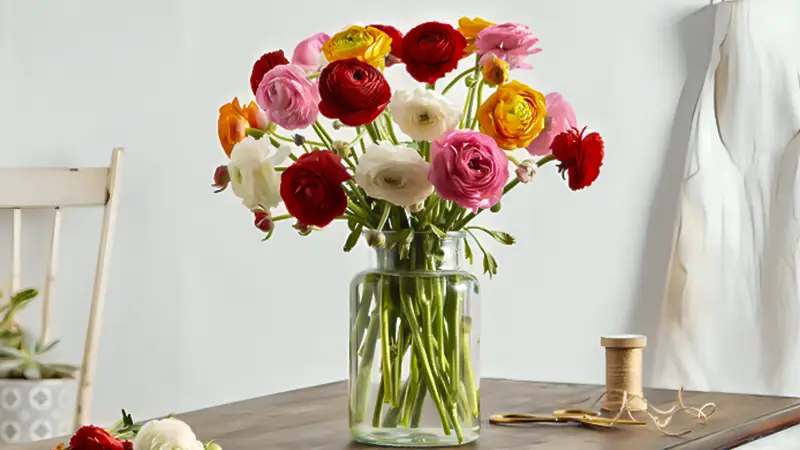
Selecting the Right Plant for Your Garden
In contrast to other delicate blooms, Ranunculus is first grown from corms. Corms are little and tough bulbs that can be clawed, keeping the required nutrition for the flower to bloom. Thus, selecting the right corms for the planting season’s success is very rewarding.
Aiming for corm sizes of 6-7 cm is vital, as bigger corms usually give rise to better plants with more blooms. These tend to be the best suited for enhanced bloom rate and health of the plant over other sizes.
Ranunculus corms should be bought only after careful inspection for any evidence of damage, decay, or infestation. The best corms remain puffy and preferably hard, with their surface exhibiting only traces of wrinkles and no rot nor any sogginess.
However, corms that are hollow or squishy can indicate that the corm is overripe and cannot be planted effectively. It is always best to buy from trusted sources to avoid situations where good prices are offered, but no quality corms are available.
There are many colored Ranunculus corms on the market. Hence, please choose one that is appropriate for the design of your garden.
Steps to Selecting Ranunculus Corms
Selecting the right corms sets the foundation for vibrant blooms and healthy Ranunculus plants that will thrive throughout the Ranunculus growing season.
- Size: Choose corms that are 6-7 cm in size for optimal growth.
- Quality Check: Ensure the corms are firm, with no signs of rot or disease.
- Color Choice: Consider your garden palette—Ranunculus comes in a wide range of vibrant colors.
- Source: Always buy from trusted suppliers to guarantee healthy, disease-free corms.
Preparing Your Garden: Creating the Perfect Environment
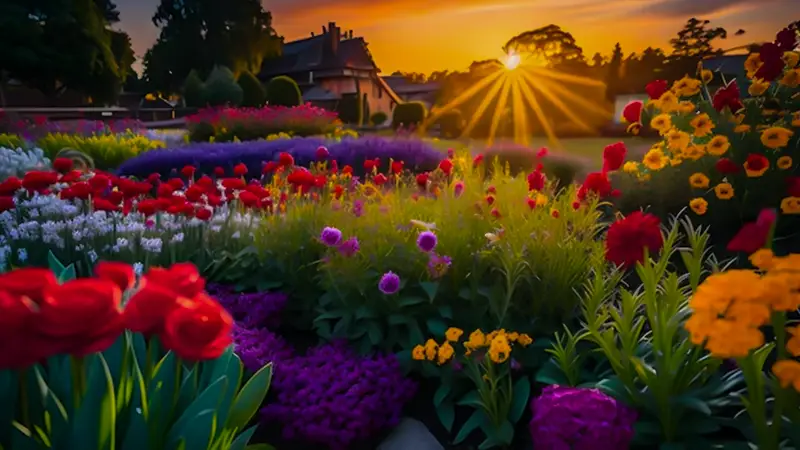
Ranunculus are cool-season plants that require specific conditions to flourish. Here are the key factors to consider for successful growth:
1. Sun Exposure Requirement
Italian Ranunculus plants require extended periods of sunshine each day. In most parts of the world, they must be cultivated under full sun conditions for optimum results. However, in very hot areas (for example, regions within USDA zones 8-10), the blooms may require a sunshade for a while to protect them against excessive sun, for instance, during the afternoon, or to avert stunting.
2. Selection of the Appropriate Site
In areas where the winters are more severe (zones 4–7), the Ranunculus corms must be already taken inside or planted in a protective cover to prevent them from frost. The flower cover should be planted within early winter or late spring to achieve summer flowers.
Since Ranunculus prefers well-drained soils, avoid planting in poorly-drained areas where water may pool, as this could ultimately rot the corms. For use in garden beds, select a sunny area with well-drained sites that have slightly acidic to neutral soils with a pH of 6.0-7.0.
3. Soil Conditions
Ranunculus cannot be grown in wet, soggy soils, so drainage is a key factor. Use a light soil with good drainage, rich in organic material. When planting Ranunculus in pots, however, a high-quality, porous soil mixture is recommended that facilitates good drainage.
In regions with dominant clay soils, it is advisable to either achieve soil amendments or grow Ranunculus in elevated containers to avoid rotting the rhizomes due to excessive wetness.
4. Air Circulation
Few plants suffer from powdery mildew as much as Ranunculus foliage does, so measures should be adopted to allow good ventilation of the area around the plants. If planting them in the garden, the distance between them should be enough (5-8 inches) to ensure that they do not breathe stale air.
Do not also compact the corms too close to each other in containers because they will need room for air and for the growth of roots.
How to Grow Ranunculus: Step-by-Step Guide
Like every other flower, Ranunculus’s planting procedure is unique and includes a few distinct steps, ensuring its health, longevity, and vibrance across all sorts of seasons. Here’s a strategic, end-to-end guide on how to plant Ranunculus.
Step 1: Pre-Sprout Corms
Before planting, you can allow the Ranunculus to jump on the growing Ranunculus season by pre-sprouting the corms. This is much needed, particularly in colder areas, since you want to ensure the plants will be the first to sprout once the ground is warm enough.
- Soak the Corms: Room-temperature water is used to soak corms for three to four hours (no more). This will make the corms pliable and ready for sprouting purposes.
- Pre-Sprout the Corms: After soaking, the corms are set on a moist seed tray or another container with a good growing mixture. They are lightly covered with 1 inch of damp soil. The tray is then kept without light but at a warm temperature (50-60 degrees Fahrenheit) for a period of 7-10 days. You will also notice the corms growing roots and small shoots within this period.
Step 2: Planting the Corms
It is time to plant corms as soon as they grow and develop a few roots. This write-up is based on both ground and container planting; therefore, adhere to these planting procedures.
- In the Soil: The sprouted corms should be planted 2–3 inches deep, with the pointed, claw-like side facing downward and the rounded side facing up. Space the corms 5–8 inches apart.
- In pots: Use a pot with a width of at least 8 inches. Place 1 corn per 8’ pot, 2 in 12′ pot, or 3 in 18’ pot so that they can grow comfortably.
Step 3: Watering and Maintenance
Once planting has taken place, apply a small quantity of water to the soil, allowing it to settle around the corms. After that, water the plant only whenever necessary and ensure that excess water does not drench the soil. Watering should be performed in the early morning to avoid water on the leaves at night, which may promote disease development.
Aim for moderate soil moisture in the beginning weeks and stay moderate with the watering. For the most part, Ranunculus plants do not need super-intense watering, especially if the weather is not hot and dry. In case they are overwatered, rot can occur; therefore, only water after checking the last watering moisture level.
When to Plant Ranunculus in Zone 7?
Ranunculus are colorful, spring-blooming flowers that thrive in a variety of climates. Knowing the right time to plant them is key to achieving a stunning display of blooms in your garden. Here’s how you should plant it in Zone 7.
- Optimal Planting Time:
- In Zone 7, plant Ranunculus corms in late fall or early spring, depending on your local frost schedule.
- For fall planting, ensure it’s 4–6 weeks before the first hard frost.
- Temperature Requirements:
- Ranunculus thrive in cool weather (40-70°F). Ensure soil temperatures are above freezing to promote sprouting.
- Pre-Planting Preparation:
- Soak corms for 3–4 hours before planting.
- Choose a sunny location with well-drained soil for best results.
Ranunculus vs. Peony
Ranunculus and peonies are both beloved for their lush, colorful blooms, but they differ in growth habits, blooming seasons, and care requirements. Below is a comparative guide between Ranunculus and Peony you must explore.
- Appearance:
- Ranunculus produces multiple layers of delicate petals, giving it a rose-like look.
- Peonies feature large, fluffy blooms with fewer but larger petals.
- Bloom Time:
- Typically blooms in late spring to early summer.
- Peonies bloom in late spring, with a shorter flowering season.
- Care Requirements:
- Prefers cooler climates and requires regular deadheading.
- Peonies are hardier, needing minimal care once established.
- Usage:
- Ideal for cut flower arrangements due to its long stems.
- Peonies are often used in landscaping as a perennial focal point.
Caring for Your Ranunculus Plants
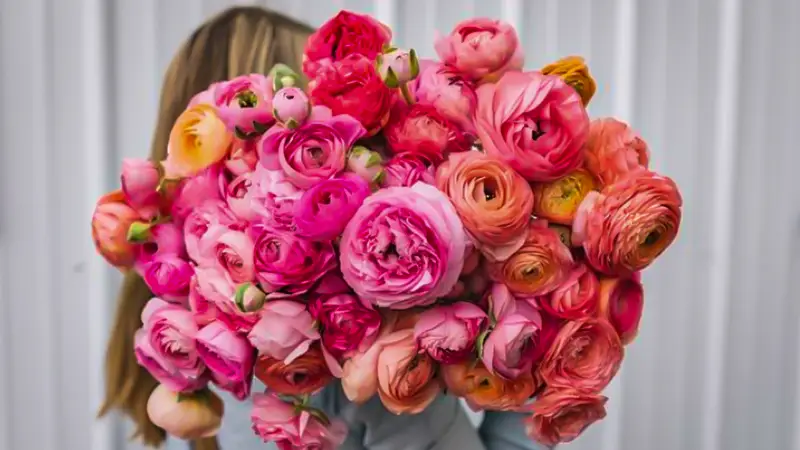
Once planted, it’s important to provide the right care for Ranunculus to ensure they thrive and produce beautiful blooms.
Light and Temperature
Ranunculus is a cool-weather flower, best suited to temperatures between 55°F and 65°F (13°C to 18°C). In colder climates, Ranunculus should be grown undercover or indoors until the risk of frost has passed. In warmer zones, Ranunculus should bloom from late winter to early spring, depending on when they were planted.
Fertilizing
This flower does not require heavy feeding but can benefit from a light fertilizer application. Use a balanced, slow-release fertilizer in the spring to encourage healthy growth and abundant blooms. Avoid overfertilizing, as too much nitrogen can produce lush foliage but fewer flowers.
Deadheading and Pruning
Deadhead blooms regularly to encourage the plants to produce more flowers. As the flowers start to fade, trim them back at the base of the stem to prevent the plant from wasting energy on old blooms. This will help ensure that the plant redirects its energy to producing new, fresh flowers.
Dealing with Pests and Diseases
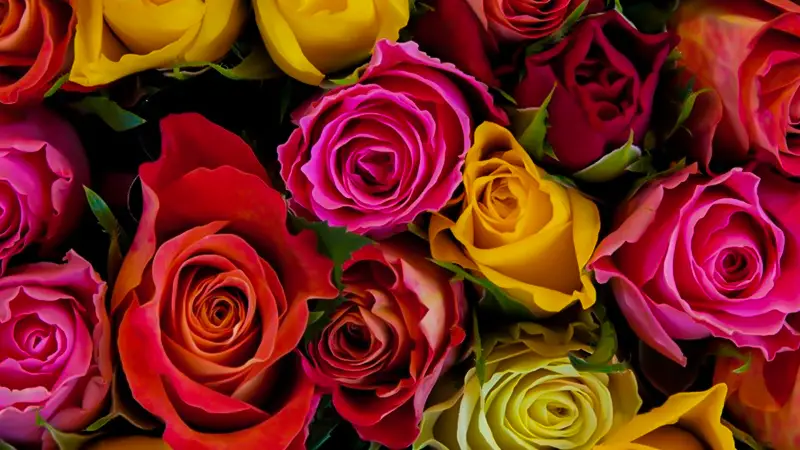
Despite their general resistance to pests, Ranunculus can be exposed to some common garden issues, including:
- Powdery Mildew: High moisture content combined with no ventilation leads to powdery mildew, which can be prevented by planting distance among plants, maintaining proper airflow, and watering in the morning.
- Aphids: They are small green or black insects that feed on the plant’s juices. Replace aphids away from the plant using strong jet water or insecticidal soap on the plants.
- Fungal Diseases: These can commonly be avoided by ensuring the soil used is not waterlogged and properly drained.
Pruning and Harvesting Your Ranunculus Flowers
Ranunculus flowers typically bloom 90 days after planting. Once they bloom, you can enjoy their beautiful, rose-like blossoms for 4 to 6 weeks. To extend the life of flowers, harvest them just as the buds begin to show color, but before they fully open.
To cut Ranunculus for floral arrangements, use a sharp knife or pruning shears, cutting the stems at an angle to ensure maximum water uptake. Keep the flowers in water immediately to prevent wilting.
Storing Ranunculus Corms for Next Season
After the blooming season ends, Ranunculus corms can be lifted and stored for replanting the following year. To store the corms:
- Wait until the foliage has yellowed and died back naturally.
- Gently lift the corms from the soil, not damaging them.
- Dry them in a warm, airy location for about a week.
- Once dried, store the corms in a paper bag or box in a cool, dry place until it’s time to plant them again the following season.
Conclusion
This flower is suitable for almost every gardener who wants to magnify the beauty of his/her spaces. Thanks to its many bright colors, complex covering of petals, and delayed blooming time, it will certainly take a central place in your garden.
Whether for a summer flower arrangement or just to enhance the beauty of the landscape around the house, the Ranunculus is one of the best flowers to grow.
By simply implementing the basic steps mentioned above, which range from soil preparation to caring for your plants, you can have the beauty of Ranunculus flowers every other year.
Can Ranunculus grow in India?
Yes, Ranunculus can grow in India, especially in regions with a mild, temperate climate. For optimal growth, ensure they receive plenty of sunlight and are planted in temperatures between 15 °C and 24 °C.
Is Ranunculus a permanent plant?
Ranunculus can be either annuals or perennials, depending on the growing conditions. Annuals are removed after flowering, while perennials can regrow from Ranunculus bulbs left in the soil.
Does Ranunculus like the sun?
Yes, Ranunculus thrives in full sun but can also grow in partial shade. For best results, ensure they receive rich, well-draining soil and sunlight throughout the day.
Does Ranunculus smell?
Ranunculus flowers are typically scentless, making them ideal for people sensitive to strong fragrances. If you prefer, you can still enjoy their beauty outdoors without the concern of overpowering scents.
How long will Ranunculus last?
If cut when the buds are firm yet slightly squishy, cut Ranunculus can last 10 to 12 days in a vase. Fully open blooms last about a week, but may be more delicate for transport.

